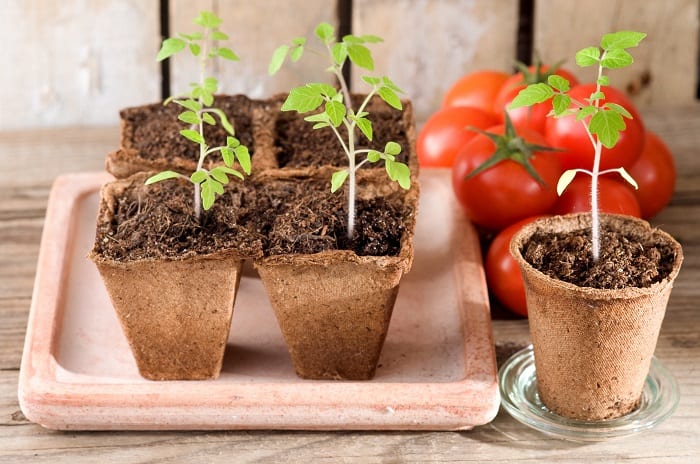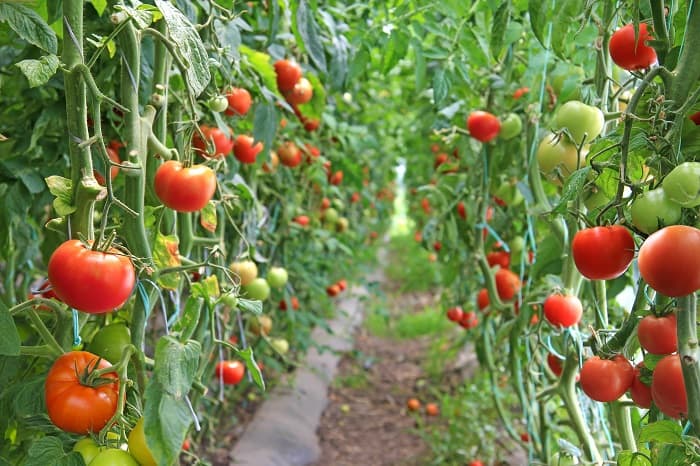Tomatoes are one of the staples in most plant-based cuisine. However, just knowing where to get them isn’t enough. If you want to have a steady supply of fresh and naturally produced tomatoes, you must also know how to grow them yourself.
When it comes to planting, composting is one of the key factors. If you’re struggling to make compost on your own, then don’t worry. We have prepared some of the key components you can take into account to help you make the best compost for tomatoes.
Farm-to-Table Initiative
The rise to vegan and organic dining had people thinking where their food is coming from – a questioned answered by the Farm-to-Table movement. With that, it’ll be less of a worry for you if you planted your own fruits and vegetables.
At the very least, you get to be sure that your food won’t contain any harmful chemicals and insecticides.

Growing Area
Tomatoes thrive under the sunlight. In fact, they require 8 hours of direct sunlight, that is why you must place them in a strategically sunny area. They also need lots of water and aerated
Soil Preparation
When working on the
Nutrient Requirement
Every plant requires a different combination of elements that will work best for them in terms of fruit yield or blossom. Fertilizers are composed mainly of three key elements: nitrogen (N), phosphorus (P), and potassium (K).
Each of these elements contributes to the fruit yield, size, plant height, and the number of branches.
One of the things you should not include is urea and ammonium nitrate in your fertilizer as they can be toxic to the seedlings. Aside from that, they may also cause plant injury when placed in close proximity to the plant.
Compost Chemistry
Various key elements serve a purpose in your compost, and the elements that make up your compost will determine its composition. They’re as follows:
Nitrogen (N)
- Vital for plant cell growth and function
- Part of the chlorophyll component that creates the green pigment in leaves
- Speeds up the growth of shoots and buds
- Results in higher fruit yield and bigger fruit size
Phosphorus (P)
- Regulates protein synthesis for the plants
- Allows the plant to produce strong roots, rich foliage, and plenty of flowers
Potassium (K)
- Aids in photosynthesis and the plant’s intake of carbon dioxide
- Increases your plant’s resistance to drought and temperature changes
- Increases resistance to insects and pests
- Produces fruits that ripen evenly
Carbon (C)
- Serves as the energy source for the entire process of decomposition
- Can be taken from wood and paper inclusions
- Must work hand-in-hand with nitrogen in order to be processed properly
Oxygen (O)
- Can be included through
soil aeration - Used for producing carbon dioxide
- Insufficiency of oxygen will make the process anaerobic, thereby limiting microbial activity and causing odors
Trace Minerals (Calcium, Iron, Boron, Copper, etc.)
- Aid greatly in microbial processes involved in decomposition
- Act as supplements for the main components to ensure good results
pH Balance
- When beginning the compost, a pH rating between 5.5 and 8.5 works best
- A controlled pH encourages the growth of mold and fungi
- Assists in the breaking down of cellulose linings
Why Compost?
You can do your composts indoors and in your backyard depending on your space availability. However, you might wonder: why is there a need to compost?
The answer is pretty simple. Composting offers a handful of benefits aside from reducing your garbage and lowering your carbon footprint. It does the following as well:
- Reduces your use of synthetic and chemical fertilizer
- Gives you a specific disposal area for your biodegradable garbage
- Allows you to customize the nutrient composition for each plant you grow
- Produces a healthier yield due to the reduced artificial/ synthetic content
- Encourages the natural growth and production of fungi and bacteria that aid in the production of humus, a nutrient-rich material you can use for all your plants
Compost Basics
Given the ratio of nitrogen: phosphorus: potassium, we have this to consider in the attempt to make the most effective and best compost for tomatoes. Generally included in a compost are as follows:
General Compost Inclusions
- Avian waste (poultry droppings)
- Animal waste (horse, pig, cattle droppings)
- Browns and Greens/ agricultural waste (dead leaves, grass cuttings, twigs, selected vegetables, and fruits)
- Water
Inclusions to Avoid
- Synthetic fertilizers or additives
- Dog and cat poop
- Fish and meat scraps
- Non-biodegradable material
Note: Refrain from including onions and citrus peels to your compost! Yes, they are biodegradable, but they contain chemicals that can kill microorganisms. As a result, they end up delaying the entire decomposition process.
Chemical Composition
In conclusion to a study conducted in 2013, this information contains the nutrient composition of avian waste, animal waste, and agricultural waste. The following data was published by the European Center for Research Training and Development.
Avian waste has considerably higher nitrogen (N) content, lowest phosphorus (P) content, and highest potassium (K) content out of the three.
Animal waste has the lowest nitrogen (N) content, highest phosphorus (P) content, and the lowest potassium (K) content.
Meanwhile, browns and greens have the median content for all three elements.
With this in mind, the study concludes that a higher nitrogen content should be considered in order to create the best compost for tomatoes. The compost may still include the general inclusions, but you can add a little bit more of poultry droppings for that nitrogen boost.

FAQ’s
What are the types of composts that are used for tomatoes?
There are two types of compost used for growing tomatoes: “compost” and “composted manure.” Compost has been composted, or “cooked,” by microbes to break down organic matter into humus. This compost is usually sold in 5-gallon containers. Composted manure is compost that has been “decomposed” by microbes from livestock manure.
It is often sold in bulk or as a liquid in bags. The liquid manure is diluted with water and sold as fertilizer. If you want to use “compost,” you’ll need to decide how long you want your compost to be effective for. If you want it to be effective for several years, keep adding new material to the pile every year. If you want it to last only until next spring, then add new material every other year.
“Compost” refers to the finished product, not the raw ingredients. “Composted manure” is manure that has been “decomposed” by microbes. Both types of compost can be used to fertilize tomatoes. The best time to add compost is after the last frost.
What is the best soil mixture for tomatoes?
It depends on the climate where you live and the type of soil you have. A general rule of thumb is to add compost to your soil (organic matter), but a great mix would be a combination of compost, blood meal and bone meal. If you’re in a dry climate and you don’t have much soil, you can just plant in peat moss, sand or perlite.
How do you make compost for tomatoes?
If you want to make your own compost, first pick a location that is not too hot or cold. Next, find a source of organic material, such as grass clippings, leaves, or other yard waste. Spread this material on top of a layer of newspaper (or cardboard).
Then add a layer of soil. Finally, cover with more organic material. This is the simplest method of composting and will work fine for small amounts of materials.
It is not a great idea to use kitchen waste on your garden. It’s better to use it as mulch around the plants in your garden, and to add it to your compost pile. Kitchen waste can contain things that could be harmful to plants, like pesticides and chemicals from cleaning products.
What is the best compost to grow tomatoes in?
The question of what is the best compost for growing tomatoes has been asked by thousands of gardeners. The short answer is that no one compost will produce the best results for all varieties of tomatoes. What works well for one type of tomato, may not work for another variety of tomato.
It is also important to remember that a compost heap should not be used as an organic fertilizer in place of regular fertilization. Compost is a natural fertilizer, but it is not a substitute for good organic fertilizer. Composting is the act of breaking down organic material into smaller pieces that are easier to handle. These smaller pieces are then added back into the soil or placed in the yard.
Things to Remember
Now you know what is basically needed in making the best compost for tomatoes, here are a few more tips and tricks to keep in mind:
- Keep the compost moist
- Avoid non-biodegradables
- Avoid leftovers and foul-smelling waste that may attract pests
- Situate the compost pit in a shady area
- Cover the pit
- You’ll know it is ready to be used once the material becomes a rich and dark-colored mush
- It takes time and may take anywhere from months to years, but it’ll be worth it
Hopefully, the information above will help you know what you need in order to make an effective compost for your tomato plants. If you have any questions, don’t hesitate to leave a comment below.
As always, thanks for reading, and don’t forget to share this information with your gardener friends!

Josephine is an enthusiastic gardener who loves to spend her spare time tending to her garden. She is passionate about growing her own food, and aspires to one day have her own vegetable garden. Josephine is also an animal lover and often takes in stray cats and dogs. She enjoys spending time with her pets in the garden, and is often seen playing with them or watering her plants. Josephine is an avid reader and enjoys learning about new gardening techniques and plants. She is always looking for ways to improve her garden and make it more beautiful. She is a great friend, always willing to lend a helping hand when needed. Josephine‘s passion for gardening and love of animals make her a wonderful addition to any garden.




